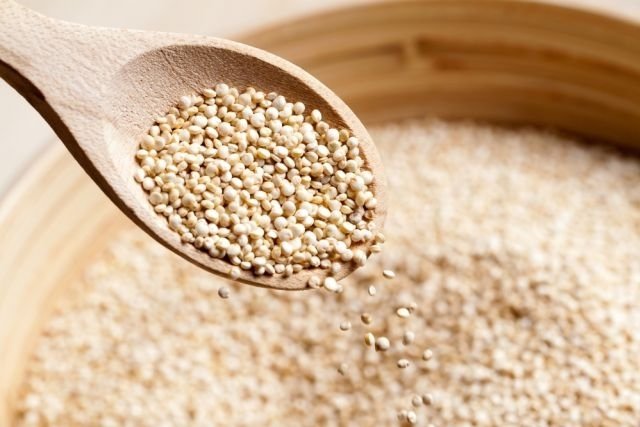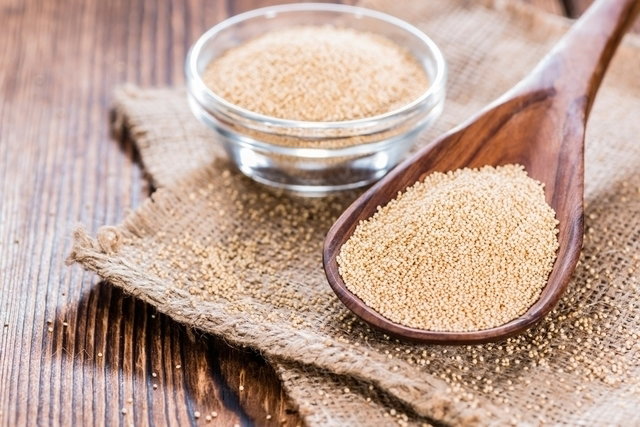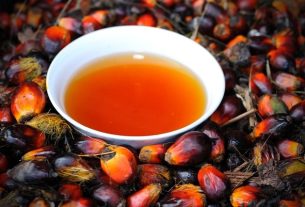Amaranth is a gluten-free pseudo cereal, rich in good quality proteins, fiber, vitamins and minerals, such as calcium and zinc, providing excellent health benefits when included in a healthy and balanced diet.
This food is more nutritionally rich than any other cereal, such as rice, wheat and rye. Amaranth can be found in grain, flour or seeds and can be used to prepare cakes or pancakes, or to add to yogurt or milk, for example.
Amaranth can be found in health food stores, supermarkets or online product stores.

Regular consumption of amaranth could provide several health benefits, which include:
1. Reduce cholesterol
It is believed that amaranth is capable of reducing bad cholesterol, LDL, as it contains unsaturated fatty acids, such as linoleic acid, which is related to lower cholesterol.
Furthermore, the presence of soluble and insoluble fiber in its composition can also promote the regulation of cholesterol levels. It is also believed that the presence of squalene and vitamin E, which are powerful antioxidants that could help inhibit the synthesis of cholesterol and increase its excretion through bile.
2. Promote muscle mass gain
As it contains good quality proteins and is rich in potassium, consuming amaranth before or after training could promote muscle growth and recovery.
3. Fight cancer
Amaranth contains squalene, a compound that has antioxidant effects and helps prevent damage caused by free radicals to cells, exerting anti-tumor properties.
4. Prevent osteoporosis
This pseudo cereal is rich in calcium, magnesium, manganese and phosphorus, minerals that are important for strengthening bones and teeth, preventing the onset of diseases such as osteopenia or osteoporosis.
5. Promote weight loss
When amaranth is part of a balanced diet and consumed in an adequate portion, it can promote weight loss, as it has few calories, is rich in protein and fiber, which help to increase the feeling of satiety and reduce hunger. .
6. Strengthen the immune system
As it is rich in antioxidants, vitamin A, C and E and minerals such as selenium, consuming amaranth helps to strengthen immune system cells, reducing the risk of developing diseases.
7. Can be consumed by those who have gluten intolerance
Amaranth does not contain gluten and, therefore, could be an excellent alternative for preparing breads, cakes and cookies for people who are sensitive or intolerant to gluten, such as celiac disease.
Amaranth nutritional information
The following table indicates the nutritional composition in 100 grams of raw or cooked amaranth:
It is important to mention that to have all the benefits mentioned above, amaranth must be part of a healthy and balanced diet.
How to consume amaranth
Amaranth can be added to smoothies, fruit salads, raw salads, yogurts and cereals. It can also be used as a substitute for wheat flour to prepare cakes and cookies, as well as to replace rice, pasta and quinoa.
To cook amaranth, you must place 1 cup of amaranth grains in 3 cups of water. Once it boils, reduce the heat to low and keep it for about 25 minutes or until the water is absorbed.
Amaranth can be stored in the refrigerator for 6 months in a tightly closed container to prevent moisture from entering.
Amaranth recipes
Some recipes that can be prepared with this cereal are:
1. Amaranth pie with quinoa
Entering:
- 1/2 cup of quinoa grains;
- 1 cup of amaranth flakes;
- 1 ovo;
- 4 tablespoons of olive oil;
- 1 grated onion;
- 1 chopped tomato;
- 1 mashed cooked carrot;
- 1 cup chopped cooked broccoli;
- ¼ cup of skimmed milk;
- 1 can of drained tuna;
- 1 tablespoon of baking powder;
- Salt to taste.
Preparation mode:
In a bowl, mix all the ingredients. Spread into a mold and place in the preheated oven for 30 minutes or until golden.
Quinoa grains and amaranth flakes can be found in health food stores or supermarkets.
2. Gelatin with amaranth
Ingredients:
- 50g of amaranth flakes;
- 1 cup of gelatin or 300 ml of fruit juice.
Preparation Mode:
Just add it to fruit juice or even gelatin after training, as well as being tasty, it is also very nutritious.
3. Pancake with amaranth
This recipe is a great option for breakfast and can be used by people who want to lose weight and diabetics, as it is low in calories and helps regulate blood sugar levels.
Ingredients:
- 1/2 cup amaranth flour;
- 1/2 cup whole wheat flour;
- 1/2 cup cornstarch;
- 2 teaspoons of yeast;
- 1 teaspoon of baking soda;
- 2 cups of milk;
- 2 large eggs;
- 1/2 cup canola oil;
- 2 cups of blueberries or strawberries.
Preparation mode:
Mix the milk, eggs and oil until you obtain a creamy consistency and let it rest for 5 minutes. Then add the dry ingredients and fruit.
If the dough is too thick, you can add a teaspoon of water to make the dough a little more liquid. Make the pancakes in a frying pan and, once ready, add the rest of the blueberries or strawberries as filling.

Sign up for our newsletter and stay up to date with exclusive news
that can transform your routine!
Warning: Undefined array key "title" in /home/storelat/public_html/wp-content/plugins/link-whisper-premium/templates/frontend/related-posts.php on line 12
Warning: Undefined array key "title_tag" in /home/storelat/public_html/wp-content/plugins/link-whisper-premium/templates/frontend/related-posts.php on line 13




